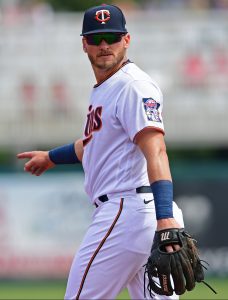Our series focusing on notable players looking for bounce-back seasons in 2020 rolls on with the National League Central. We’ll start with 10 of the division’s hitters who hope to return to form this year…
Joey Votto, 1B, Reds:
Votto is one of the greatest hitters who has ever lived, so it was rather surprising – even at the age of 35 – to see him turn in such pedestrian numbers in 2019. He ended up with what was essentially a league-average line of .261/.357/.411 with 15 home runs in 608 plate appearances, mustering just 0.7 fWAR during that span. Compared to 2018, the ever-patient Votto saw his walk rate fall by almost 5 percent, his out-of-zone swing rate jump by nearly 5 percent and his strikeout rate climb by 4 percent. Regarding his performance last year, Votto admitted in February (via Mark Sheldon of MLB.com): “It’s the worst season I’ve had in my career, pretty clearly. I don’t think it’s close. Everything went the wrong way.” Now, the six-time All-Star and former MVP is “motivated” to turn things around as part of what could be the Reds’ first contending team in several years.
Lorenzo Cain, CF, Brewers:
Cain joined Votto in logging uncharacteristically mediocre numbers last season. But Cain, a 5.7-fWAR player as recently as 2018, was clearly hampered by a right thumb injury. That issue played a part in limiting the 33-year-old to 1.5 fWAR and a .260/.325/.372 line across 623 trips to the plate. From 2018-19, his walk rate fell by 3.5 percent, his wRC+ plummeted by 41 points (124 to 83) and he stole 12 fewer bases (30 to 18).
Justin Smoak, 1B, Brewers:
One of the Brewers’ offseason free-agent pickups, Smoak is coming off a year in which he matched Votto in wRC+. That’s normally a good thing, but at 101, that wasn’t the case last season. In his final campaign with the Blue Jays, the switch-hitting Smoak only put together a .208/.342/.406 line in his 500 PA. But his hard-hit rate increased by almost 9 percent, according to FanGraphs, and Statcast was a fan of his work. Notably, the 33-year-old’s expected weighted on-base average (.366) far outpaced his real wOBA (.323).
Jedd Gyorko, INF, Brewers:
Another of Milwaukee’s offseason signings, Gyorko is on the heels of a brutal and injury-wrecked 2019 spent with the Cardinals and Dodgers. He accounted for minus-0.7 fWAR in just 101 PA, thanks in large part to an unsightly .174/.248/.250 line. Before that, Gyorko totaled three straight seasons of above-average offensive production. For an affordable $2MM, Milwaukee’s hoping a healthy version of the 31-year-old will return to his 2016-18 days.
Paul Goldschmidt, 1B, Cardinals:
There was nothing wrong with Goldschmidt’s output in 2019, per se; it just didn’t match up to the brilliance we’ve come to expect from him. A middling start to the six-time All-Star’s first season as a Cardinal tamped down his overall numbers, helping limit him to a .260/.346/.476 showing and 2.9 fWAR (though he did hit 34 home runs). Remember, Goldschmidt entered the year as a lifetime .297/.398/.532 hitter with six consecutive seasons of between 4.0 and 7.2 fWAR.
Matt Carpenter, 3B, Cardinals:
Carpenter, like Goldschmidt, was a star in the several seasons preceding 2019. But last year went awry for Carpenter, who – for the first time in his career – failed to record even average offensive production. The 34-year-old finished the season as a .226/.334/.392 hitter in 492 PA, notching a career-worst 1.2 fWAR in the process. Compared to 2018, Carpenter’s walk and strikeout rates went in the wrong direction by about 3 percent apiece, his ISO plummeted by a stunning 100 points, and his hard-hit percentage fell by eight points.
Yadier Molina, C, Cardinals:
The Cardinals are currently working to extend the 37-year-old Molina, one of the best players in franchise history, though the potential Hall of Famer wasn’t his usual self in 2019. He produced his lowest fWAR (1.2) since 2006 and batted a powerless .270/.312/.399 in 452 PA. On the other side, Molina’s caught-stealing rate went down by a few points to 27 percent (still a bit better than average), and his pitch-framing output also dropped.
Harrison Bader, CF, Cardinals:
With this many Cardinals on the list, it’s a wonder they took the division last season. Anyhow, Bader was a major contributor to the team in 2018 – his first full season – but couldn’t come close to replicating that performance in ’19. His fWAR was cut in half by 50 percent (3.6 to 1.8), largely because of a disappointing .205/.314/.366 line over 406 trips to the plate. A 4 percent increase in strikeout rate was among the culprits. To Bader’s credit, though, he did slash his soft-contact rate and continue to thrive in the outfield, where he tallied 14 Defensive Runs Saved and a 12.9 Ultimate Zone Rating.
Gregory Polanco, OF, Pirates:
It would be fair to give Polanco a mulligan for his poor year, as he underwent left shoulder surgery in September 2018 and dealt with problems in that area throughout last season. He only appeared in 42 games and amassed 167 PA, batting .242/.301/.425.
Daniel Descalso, INF, Cubs:
The typically light-hitting Descalso was so effective as a Diamondback in 2018 that it convinced the Cubs to give him a two-year, $5MM contract heading into last season. That decision has not paid off at all so far. The 33-year-old Descalso’s initial season in Chicago couldn’t have gone much worse, as he batted .173/.241/.250 over 194 PA and accounted for minus-0.8 fWAR. Among 411 hitters who racked up at least 150 PA, Descalso ranked seventh worst in wRC+ (42) and 14th from the bottom in ISO (.077). If you’re skeptical that he’ll turn back into a decent contributor this year, you’re not alone, but there’s really nowhere to go but up.

